Gubbins D., Herrero-Bervera E. Encyclopedia of Geomagnetism and Paleomagnetism
Подождите немного. Документ загружается.

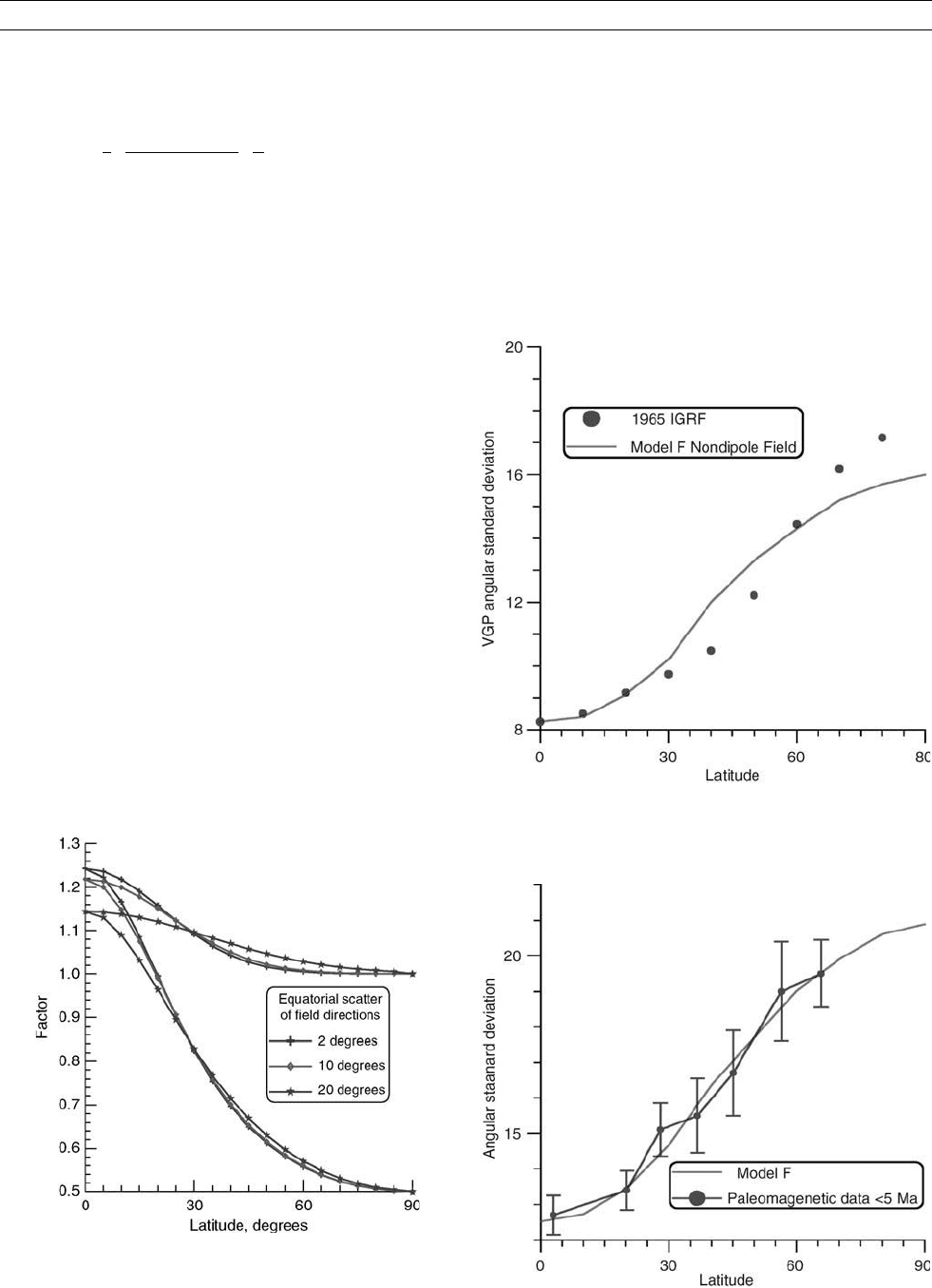
Fisherian distribution of VGP positions. Numerical mapping was then
used to determine the angular variance in field directions as a function
of latitude, which is in radians:
d
2
d
ðlÞ¼
2
3
1 þ a exp bl
2
ffiffiffiffiffiffiffiffiffiffiffiffiffiffiffiffiffiffiffiffiffi
1 þ 3sin
2
l
p
f
F
2
(Eq. 11)
where f and F are nondipole and dipole field intensities, respectively,
and a,b are numerically determined numbers. The top part of the lati-
tudinal term is plotted in Figure S8 (the top three curves, asymptotic
to 1). The whole of the latitudinal term is plotted as the bottom
three curves asymptotic to 0.5. What these curves mean is that if
the ratio of f/F is constant, then the variance in direction will fall by
a factor of somewhat greater than 2 on going from the equator to the
poles. This latitudinal term was found numerically. McFadden and
McElhinny (1984) believed that f/F was in fact constant, i.e., the non-
dipole field varied with latitude just like the dipole field. Numerical
techniques also have to be used to transfer field variance into VGP
variance. The result is that the nondipole latitudinal variation of
VGP scatter increases by a factor of about 1.93 (W(l)) on going from
equator to pole. A fit to the 1965 IGRF nondipole field is shown in
Figure S9. Figure S10 shows the fit of model F to the paleomagnetic
data aged less than 5 Ma, and it can be seen that there are no serious
deviations. But it should be stressed that this fit was achieved by the
omission of low-latitude VGPs, to allow the nondipole part of model
F to fit in general with the 1965 IGRF (Figure S9).
Model G was proposed by McFadden et al. (1988), and was
described by Merrill et al. (1996) as the only phenomenological model
of the paleosecular variation. It is based on separation of the field into
a dipole family and a quadrupole family. The dipole family consists of
the axial dipole plus all spherical harmonics whose degree and order
add up to an odd number. The quadrupole family consists of those
spherical harmonics whose sum of degree and order is even. They
found out that, using the 1965 IGRF, if the field generated by the
dipole family is rotated around the spin axis, the resulting scatter of
VGPs, as a function of latitude, is zero at the equator and grows line-
arly with latitude up to 70
where it is about 15
. When the quadrupole
family plus the axial dipole are rotated around the spin axis, the VGP
scatter scarcely varies and is about 13
. Since the scatters from the
quadrupole and dipole families are independent due to the large size
of the axial dipole, model G is just the quadrature sum of the dipole
and quadrupole families and is given by the following equation:
S ¼
ffiffiffiffiffiffiffiffiffiffiffiffiffiffiffiffiffiffiffiffiffiffiffiffiffi
A
2
l
2
þ B
2
q
; (Eq. 12)
where S(l) is the VGP scatter, A is the constant showing rise of dipole
scatter with latitude, l, and B is the constant quadrupole scatter. With
A ¼ 0.21 0.01 and B ¼ 13.6 0.3
(both showing 95% confidence)
the fit to the 1965 IGRF is excellent as is the fit to the VGP scatter
obtained from paleomagnetic samples over the past 5 Ma, provided
that high latitudes are not considered (Figure S11).
Figure S8 Top latitude term in (11) is given by upper curves
asymptotic to 1, as a function of three equatorial field scatters.
Bottom curves asymptotic to 0.5 show total latitudinal term
from (11).
Figure S9 Fit of model F to 1965 IGRF. The nondipole parts of
these are shown here.
Figure S10 Model F fit to the paleomagnetic data aged <5 Ma.
896 SECULAR VARIATION MODEL
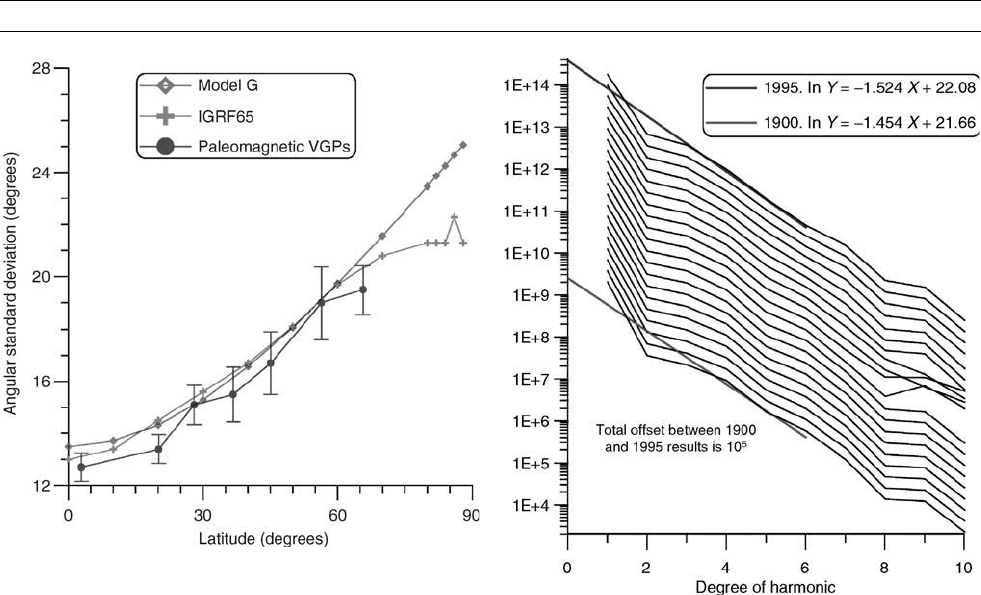
Unfortunately if other periods of time when the field is well known
are looked at, the shape of the scatter produced by the field changes
considerably (Harrison, 1995; Hulot and Gallet, 1996). Basically, the
latitudinal variation has grown continuously for well over 200 years.
In 1770, the scatter rose from 12
(equator) to 13.5
at high latitudes.
In 1840, the change was from 12.5
to 17
, and in 1990, the change
was from 13
to 22
. So it is just coincidental that the paleomagnetic
field and the 1965 field gave similar results in 1965. At other epochs
the similarity is not there.
There are, however, aspects of the recent measurements of the
Earth’s magnetic field that do not change very much over 300 years.
The equivalent of the power spectrum in two-dimensional signals is
replaced by a different function when measurements are taken over a
spherical surface. In this case it has been shown by Mauersberger
(1956) and Lowes (1966) that the mean square value of the field over
the sphere as a function of degree of harmonic is given by the follow-
ing function:
R
n
¼ðn þ 1Þ
X
n
m¼0
g
m
n
2
þ h
m
n
2
hi
: (Eq. 13)
The degree of harmonic is roughly equivalent to the wavenumber in a
linear system. This function is plotted for the IGRF for 5-year intervals
in Figure S12. There are some obvious errors in the data, i.e., there are
some peculiarities in the higher degrees of harmonic in the middle
years of this presentation. But in general the power falls off as a func-
tion of degree of harmonic quite uniformly from one representation of
the field to the next. Analyses of the field back to 1690 (Harrison,
1994) show similar behavior, with some possible small changes due
to the fact that the earlier field models lacked data to define the higher
degree harmonics accurately.
Models based on spherical harmonics
The Giant Gaussian Distribution model of Constable and Parker
(1988) attempted to derive a spherical harmonic spectrum for the
geomagnetic field based on the supposition that the power spectrum
(Lowes-Mauersberger function) for degrees 2–12 evaluated at the
core-mantle boundary is statistically flat. The Gauss coefficients are
chosen from a zero-mean Gaussian distribution with the appropriate
standard deviation for each degree. However, no statistical variation
as a function of order is allowed. Because of this, this model, despite its
elegance, does not produce any variation of VGP scatter as a function
of latitude, and since this is one of the main findings of paleomagnetic
work on younger lava flows, it fails as a model. Later attempts to mod-
ify this model, while giving a more satisfactory latitudinal variation of
VGP scatter, make the model much less elegant, one of the attractive
features of the original model. For instance, Constable and Johnson
(1999) produced a model in which the standard deviation of Gauss
coefficients changed as a function of harmonic order, but only for
degree 2. Quidelleur and Courtillot (1996) and Kono and Tanaka (1995)
have also suggested modifications to the Giant Gaussian Distribution to
explain the VGP scatter variation as a function of latitude. We
shall see that modifications to the Gauss coefficients are necessary
to obtain a reasonable model.
Another model of the geomagnetic field
One other model that deserves mention is that suggested by Camps
and Prévot (1996). They used a field model (i.e., they specified the
statistical properties field components at two latitudes). Their dipole
field was drawn from that produced by a normal distribution of dipole
strength, in which the standard deviation was 45% (high latitude) or
50% (low latitude) of the mean. The nondipole field was modeled
by Maxwell Boltzmann probability density function (in which each
Cartesian field coordinate is drawn from a zero-mean Gaussian distri-
bution, all with the same standard deviation). In contrast to almost all
models already discussed they did not use the present day field to
Figure S11 Model G fit to IGRF65 rotated around geographic axis
and to paleomagnetic data <5 Ma old from which low latitude
results have been removed.
Figure S12 Lowes-Mauersberger function for the IGRF between
1900 (bottom) and 1995 (top). Each graph is displaced by
a common multiple (equal to 10
5=19
) from its nearest neighbors
for clarity. The red and blue straight lines are best fitting lines
through degrees 1 to 6 for the 1900 and 1995 fields.
SECULAR VARIATION MODEL 897

constrain their model, neither did they restrict their data to lava flows
that only gave high latitude VGPs (to quote from their paper
“... implies that paleosecular variation is physically distinct from the
reversing regime. We know of no observation that has confirmed this
view.”). However, their model did not provide a complete description
of the field because they essentially divided up the observations into
high latitude and low latitude, and did not try and join the two.
Source models of the geomagnetic field
Several people have produced source models of the geomagnetic field.
Dodson (1980) used a series of dipoles buried within the core to repre-
sent the nondipole field of Earth. He used up to 20 dipoles located at
the CMB for this purpose and found that he had to concentrate the off-
centered dipoles close to the geographic axes to achieve the necessary
variance of VGP scatter as a function of observation latitude. Kono
(1971) developed a model in which the nondipole field was repre-
sented by small dipoles oriented either parallel or antiparallel to the
central dipole with uniform moment. One of his models had 80 dipoles
whose intensity was equal to the central axial dipole divided by 80. If
the central axial dipole has a strength of 30 mT (like that of today),
then the noncentral dipoles will have a strength of 375 nT.
A new source model of the geomagnetic field
Model H (after model G of McFadden et al., 1988), is presented here.
A complete explanation is found in Harrison (2004, 2006). The model
is summarized in Table S1. The model is a variation of the one pro-
posed by Dodson (1980) and consists of dipolar sources placed within
the core to simulate the electric currents that cause the geomagnetic
field. The central dipole source is assumed to be axial and is allowed
to vary about its mean value that is taken to be a simple number close
to the axial component today (30 mT). Since directions are determined
by ratios of Gauss coefficients there is no loss of generality in choos-
ing the central dipole source in this way. No allowance is made for far
sided effects. The off-centered dipoles are buried sufficiently deeply
within the core so that the correct slope to the Lowes-Mauersberger
function is obtained (Figure S12). This is at a depth of 0.4R
e
. If the
dipole sources are placed at the CMB (Dodson, 1980) the absolute
slope is far too small. Deep burial well below the CMB achieves
the correct observed slope of –0.55. Note that this aspect of the
Lowes-Mauersberger function is about constant for the past 300 years,
in contrast to the VGP scatter as a function of latitude that varies con-
siderably over this time period. Benton and Alldredge (1987) sug-
gested a depth of 0.404R
e
. The present day field variation of VGP
scatter as a function of latitude is not used to constrain the model,
because it has changed considerably over the past few hundred years.
With this constraint gone, there seemed to be no reason to try and
separate the field behavior into a “secular variation” mode and a
“reversal or excursion” mode, and so VGPs from all latitudes were
considered, following Camps and Prévot (1996).
How does the latitudinal variation of VGP scatter come about? This
is determined by the fact that analysis of the present day field reveals
that there is a variation in strength of Gauss coefficients as a function
of order within each degree. This is shown in Figure S13. Figure S13,
which shows the relative strength of the squared Gauss coefficients
which are normalized so that mean squared values of the reduced coeffi-
cients in each degree are equal to 1. This is equivalent to the following:
X
n
m¼0
G
m
n
2
þ H
m
n
2
hi
¼ n þ 1 ; (Eq. 14)
where
G
m
n
¼ c
n
g
m
n
; (Eq. 15)
H
m
n
¼ c
n
h
m
n
; (Eq. 16)
and c
n
is a constant for degree n.
Figure S13 demonstrates that the high-order harmonics within each
degree tend to be smaller. The zeroth degree harmonics (m ¼ 0) tend
to be the highest of all, while the sectoral harmonics (m ¼ n) are
mostly small, especially in 1995.
Figure S14 shows the difference between low-order harmonics
and high-order harmonics in all harmonics up to degree 8. The
harmonics are normalized in the same way as in Figure S13.The
Table S1 Methods of determining model parameter values
Item Parameter Method of determination
1 Mean central axial dipole intensity Free parameter, made about equal to present day dipole, or 30 mT
2 Central axial dipole intensity variati on
(standard deviation of central dipole)
Governed by comparison with latitudinal variation of Icelandic VGPs. Different
standard deviations are each tried a number of times and compared with observed
distribution of VGP latitudes using random numbers to generate specific models for
a given SD. Results show that 0–10% variation is permissible, but that higher
variation does not give as good a fit
3 Off-centered dipole depth (constant for a
specific model)
Chosen to fit the Lowes-Mauers berger function for geomagnetic field over past
300 years (Figures S12). Depth is at 0.4R
e
4 Number of off-centered dipoles Chosen to fit the latitudinal distribution of Icelandic VGPs. For each number of
dipoles their intensity, as given by the standard deviation of a zero-mean
Gaussian distribution, was varied so as to give the best fit to the Icelandic data.
The number of dipoles which gave the best fit was 90, the number used in later
calculations
5 Polar concentration of off-centered dipoles Chosen by comparison with VGP scatter calculated for different latitudinal
observations (Figure S10). Random numbers used to choose hemisphere (equal
probability), absolute latitude (according to a Fisher distribution). The Fisher
precision parameter, k,is3
6 Longitude of off-centered dipoles Chosen by random number so that probability of any longitude is uniform
7 Variation of off-centered dipoles Zero-mean Gaussian distribution with standard deviation fixed by comparison with
Icelandic VGP data. See item 4. With 90 dipoles, the standard deviation is 1040 nT.
To fit more restrictive data sets the standard deviation has to be reduced to 740 nT
(see Figure S10)
898 SECULAR VARIATION MODEL
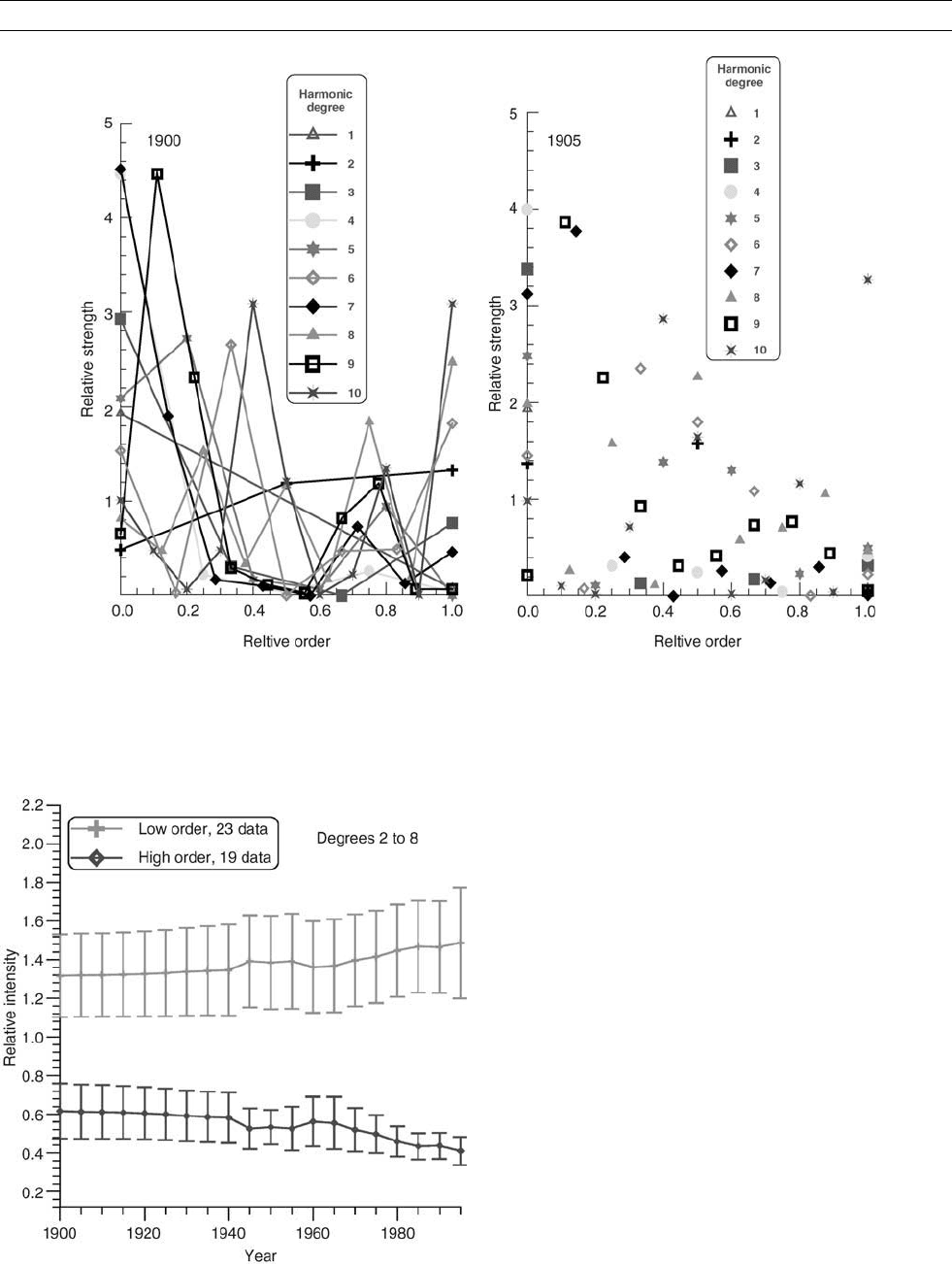
low-order harmonics (m n/2) were averaged and the high-order har-
monics (m > n/2) were separately averaged and plotted as a function
of time. It can be seen that the average of the low-order harmonics
is consistently more than twice as large as the average of the high-
order harmonics. During the last few decades the low-order harmonics
are on an average greater than three times as large as the high-order
harmonics. This effect is seen in models of the field going back more
than 300 years (Harrison, 1994), if the analysis is restricted to degrees
lower than 6. This will include almost all of the information necessary
for paleomagnetic observations of direction, since harmonics higher
than five make almost no difference to directional observations. This
indicates that the difference between high and low harmonics is a more
permanent aspect of the geomagnetic field than the difference between
northern and southern VGP scatters.
The characteristic of the low-order harmonics being in general
greater than the high-order harmonics is closely connected with the
necessity of having greater scatter in VGPs observed at high latitudes
compared with the scatter at low latitudes. The gradual increase in the
difference between low-order and high-order harmonics is mirrored by
the gradual increase on the difference in VGP scatter from low-latitude
observations to high-latitude observations. By having low orders stron-
ger than high orders, low-latitude observation points have in general
smaller nondipole fields than do high-latitude observation points. This
is because in the expression for spherical harmonics of order m there is
a term in sin
m
y, which is concentrated more and more at the equator
as m is increased. This is illustrated in Figure S15 with one example,
which shows all of the degree 6 associated Legendre polynomials as
a function of colatitude, y.
Figure S13 Squared values of reduced harmonics are plotted against relative order (m/n). Harmonics are reduced so that in each
degree, the average squared harmonic is 1. Left, field for 1900 with harmonics in the same degree connected by lines; Right, field for
1995. Each degree is plotted using a different color and symbol.
Figure S14 Low-order harmonics and high-order from degrees
2 to 8, and normalized so that in each degree the harmonics
average unity, plotted against epoch. Standard errors are shown.
SECULAR VARIATION MODEL 899
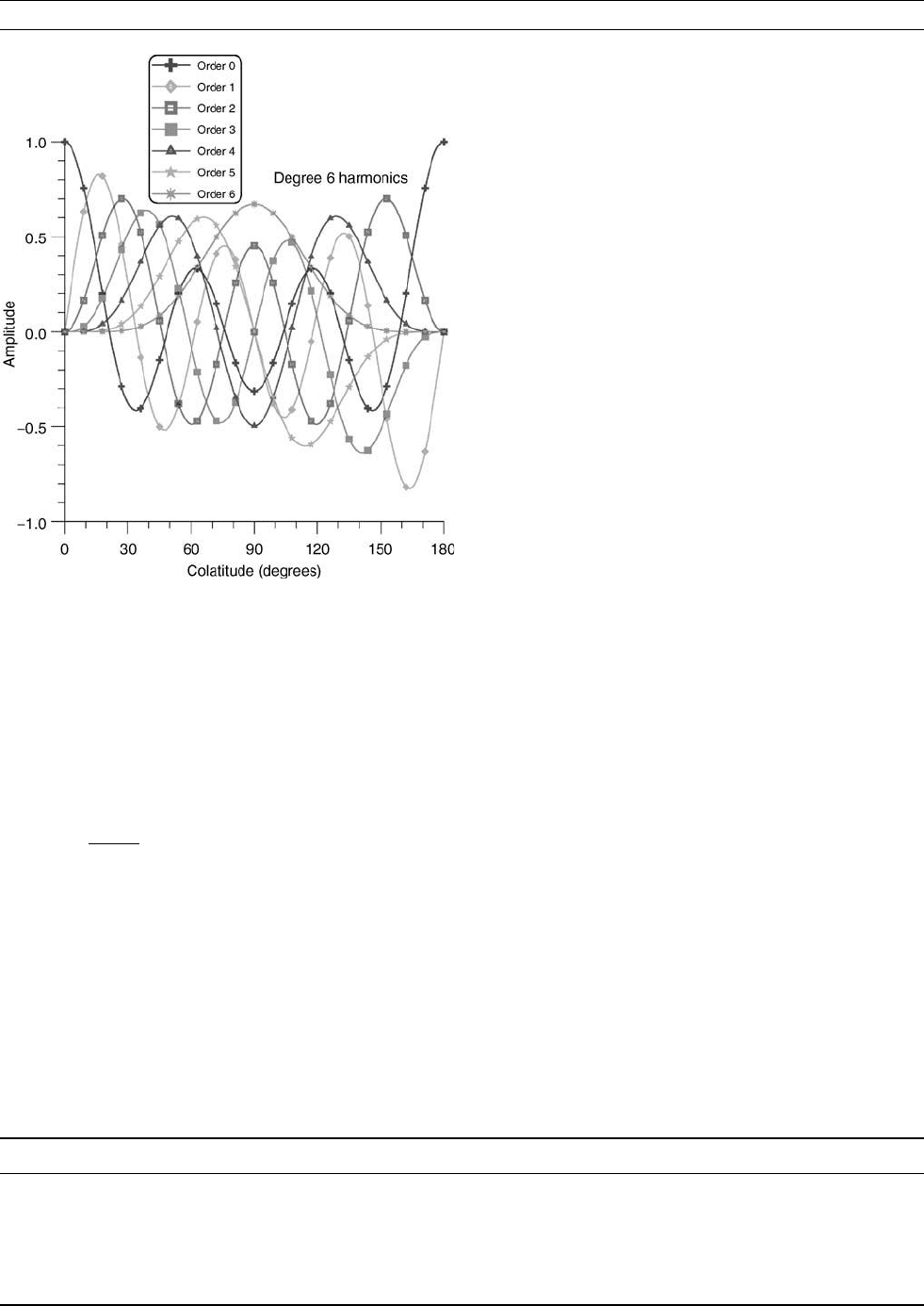
In order to achieve the higher scatter of VGPs at high latitudes, it
was found that the nondipole sources (radial or vertical dipoles placed
at a depth of 0.4R
e
) had to be concentrated towards the poles and this
was done by distributing them according to Fisher (1953) distribution.
This distribution was used by Dodson (1980) in his model. The Fisher
distribution is given by the following equation:
P
y
dy ¼
k
2 sinh k
e
k cos y
sin y dy: (Eq. 17)
P
y
dy is the probability of finding a dipole within an angular distance
between y and y þ dy from the mean (in this case the poles). k is the
Fisher precision parameter and is equivalent to 1/variance in a normal
distribution. Large values of k give tight groupings. A double-sided
distribution is used. The best value of k was found to be 3. This is
smaller than the value used by Dodson (1980) and smaller than the
value suggested by the scatter in the present day field. But it does give
a factor of 10 difference between frequency of sources at the equator
and sources at the poles if the double-sided distribution is used where
both hemispheres of the distribution are added together. In other
words, the value of (e
3
þ e
3
)/2e
0
is about 10.
Each separate representation of the field is determined in the follow-
ing way. Ninety off-centered dipoles are placed at a radius of 0.4R
e
.
Each longitude is random and determined using a random number gen-
erator. The hemisphere of each dipole is randomly determined by
another random number such that each hemisphere has an equal chance
of being chosen. The strength of each dipole is taken from a zero-mean
Gaussian distribution using another random number. The latitude of each
dipole is chosen from a distribution given above, using another random
number. The central dipole is chosen from a Gaussian distribution whose
mean is 30 mT and whose standard deviation is relatively small (less than
10% of average). All of these values are chosen to fit specific distributions
of VGPs from lava flow data from Iceland. Because of my belief in
Camps and Prévot’s statement that there is no rational way of choosing
the boundary between “normal” field directions and “abnormal” field
directions or VGPs, I used VGPs of all latitudes. Once a model has been
completely specified the field so produced is rotated around the spin axis
to generate a field variation at any specified observation latitude, from
which a VGP scatter is obtained, as well as other parameters such as field
strength, etc. The whole process is repeated sufficiently often to enable
statistical characteristics to be obtained. The model calculations are then
compared with observations.
Basic characteristics are obtained by comparison with the frequency
plot of VGP latitudes observed in Icelandic lavas. This enabled us to
fix the central dipole standard deviation to be small compared with its
mean, and the number and standard deviation of the off-centered dipoles
(90 dipoles and an SD of 1040 nT). Depth of off-centered dipoles is
governed by the desirability of producing the correct slope to the
Lowes-Mauersberger function plotted against degree of harmonic.
Polar concentration of off-centered dipoles is chosen to give the best
fit to the VGP scatter as a function of observation latitude determined
from paleomagnetic information.
This model agrees with other data, as shown in Table S2. This
model then, predicts several aspects of the Earth’s magnetic field as
well as or better than any other model. But are there other things that
the model predicts which will make it stand out from its competitors?
It turns out that there is one further property in which the model agrees
with Icelandic data. Figure S16 shows how the magnetization intensity
varies as a function of VGP latitude. If magnetizations are separated
into those that come from VGPs lying within the longitudinal quadrant
centered on Iceland, the reduction in intensity as the VGP latitude is
decreased is smaller than for those results whose VGPs lie within the
other three quadrants (Harrison, 2004). An alternative more sophisti-
cated model is to measure the fraction of variance of magnetization
that is explained by the distance of the VGP from the pole. This is
0.178 for the observed data and 0.355 for 2000 model data. Then
further calculations are done where the distance from a point between
the geographic pole and Iceland is used instead of colatitude. As this
point is moved from the geographic pole toward Iceland, the fraction
of variance explained increases and then decreases. Results are shown
in Figure S17. The fact that the model data show a higher degree of
variance, explained by distance from pole or other location close to
the pole, is because in contrast to the Icelandic data, there are no spur-
ious effects causing magnetization to vary in the model data compared
to the Icelandic data. This experiment is another prediction from the
model that is mirrored in the observations from Icelandic lava flows.
Figure S15 Associated Legendre polynomials for degree 6. As the
order is increased the harmonics take on very low values for
latitudes close to the poles.
Table S2 Agreement with observations
Observation Reference
Symmetrical distribution of directions at high latitudes Camps and Prévot (1996)
Assymetric distribution of directions at low latitudes Tanaka (1999)
Symmetric distribution of VGPs at high latitudes Camps and Prévot (1996)
Symmetric distribution of VGPs at low latitudes Tanaka (1999)
Agreement with paleofield intensity in Iceland as a function of VGP latitude Harrison (2004)
Agreement with paleofield intensity distribution from Iceland Harrison (2004)
900 SECULAR VARIATION MODEL

Implications
Model H predicts that the nondipole field should have stronger sources
at high latitudes. The ratio of source strength at the poles to the source
strength at the equator is given by:
e
k
þ e
k
2e
0
; (Eq. 18)
where k ¼ 3 is the value of Fisher’s precision parameter necessary to
give the correct polar concentration of nondipole sources. This is a
“double” Fisher distribution, with the distribution from the back half
of the sphere added to the front half, to mimic what is done to VGPs,
which are represented by their antipoles if they fall in the southern
hemisphere. This expression is equal to 10. Modelers who have stu-
died the generation of Earth’s magnetic field have frequently remarked
on the importance of the tangent cylinder to the inner core. This tan-
gent cylinder (whose axis is parallel to the rotation axis) impinges on
the surface of the outer core at a latitude of 70
. Busse (1975) empha-
sized the importance of convective rolls running parallel to the
spin axis and tangent to the inner core in his discussion of Earth dyna-
mos. Gubbins and Bloxham (1987) pointed out that patches of
high flux were located close to the tangent cylinder. Others have
shown that there is more activity within the tangent cylinder. Kuang
and Bloxham (1997) showed that there was more differential circula-
tion within the tangent cylinder than elsewhere, and Glatzmaier
and Roberts (1995) showed that there were strong toroidal fields and
differential rotation within the tangent cylinder, suggesting that these
might be strong sources for the nondipole field preferentially happening
at high latitudes.
The radial dipoles placed within the outer core used in this model
represent the sources of the nondipole field. They are deeply buried
within the outer core because the slope of the Lowes-Mauersberger
function requires this. These dipoles may represent core-surface
sources that are spread out over a finite area. For instance, core
surface current loops of finite radius will produce Lowes-Mauersberger
functions that slope at about the right amount if they have a radius
of about 1600 km (Harrison, 1994). A loop of this radius also
gives a low power for degree 8, as is observed in the present day field
(Figure S12). The off-centered radial dipoles could on the other
hand represent sources deep within the core, unless conductivity
considerations prevent sources at this depth from influencing the rela-
tively rapidly changing core surface nondipole field. Further details of
this model are to be found in Harrison (2006).
Christopher G.A. Harrison
Figure S16 Relative intensity of Icelandic lava flow magnetization
plotted against VGP latitude and compared with results
generated by model. Both ordinates are logarithmic.
Figure S17 Fractional variance of logarithmic intensity explained by distance from a point lying between the North Pole and
Iceland. The left-hand graph shows results from 2000 model calculations. The maximum is observed at a displacement of 7.4
.
The right-hand graph shows magnetization results from Icelandic lavas. The maximum is observed at a displacement of 5.6
.Parabolas
in blue are used to determine maximum values.
SECULAR VARIATION MODEL 901

Bibliography
Baag, C., and Helsley, C.E., 1974. Geomagnetic secular variation
model E. Journal of Geophysical Research, 79: 4918–4922.
Benton, E.R., and Alldredge, L.R., 1987. On the interpretation of the
geomagnetic energy spectrum. Phyics of the Earth and Planetary
Interiors, 48: 265–278.
Busse, F.H., 1975. A model of the geodynamo. Geophysical Journal
of Royal Astronomical Society, 42: 437–459.
Camps, O., and Prévot, M., 1996. A statistical model of the fluctuation
in the geomagnetic field from paleosecular variation to reversal.
Science, 273: 776–779.
Constable, C.G., and Johnson, C.L., 1999. Anisotropic paleosecular
variation models: implications for geomagnetic field observables.
Physics of the Earth and Planetary Interiors, 115:35–51.
Constable, C.G., and Parker, R.L., 1988. Statistics of the geomagnetic
secular variation for the past 5 m.y. Journal of Geophysical
Research, 93: 11569–11581.
Cox, A., 1962. Analysis of present geomagnetic field for comparison
with paleomagnetic results. Journal of Geomagnetism and Geoe-
lectricity, 13: 101–112.
Cox, A., 1970. Latitude dependence of the angular dispersion of the
geomagnetic field. Geophysical Journal of Royal Astronomical
Society, 20: 253–269.
Creer, K.M., 1962. The dispersion of the geomagnetic field due to
secular variation and its determination for remote times from paleo-
magnetic data. Journal of Geophysical Research, 67: 3461–3476.
Creer, K.M., Irving, E., and Nairn, A.E.M., 1959. Palaeomagnetism of
the Great Whin Sill. Geophysical Journal of Royal Astronomical
Society, 2: 306–323.
Dodson, R.E., 1980. Late tertiary secular variation of the geomagnetic
field in the North Atlantic. Journal of Geophysical Research, 85:
3606–3622.
Fisher, R.A., 1953. Dispersion on a sphere. Proceedings of the Royal
Society of London, Series A, 217: 295–
305.
Gellibrand, H., 1635. A Discourse Mathematical on the Variation of
the Magnetical Needle. London: William Jones.
Glatzmaier, G.A., and Roberts, P.H., 1995. A three dimensional con-
vective dynamo solution with rotating and finitely conducting inner
core and mantle. Physics of the Earth and Planetary Interiors, 91:
63–75.
Gubbins, D., and Bloxham, J., 1987. Morphology of the geomagnetic
field and implications for the geodynamo. Nature, 325: 509–511.
Harrison, C.G.A., 1980. Secular variation and excursions of the Earth’s
magnetic field. Journal of Geophysical Research, 85: 3511–3522.
Harrison, C.G.A., 1994. An alternative picture of the geomagnetic
field. Journal of Geomagnetism and Geoelectricity, 46: 127–142.
Harrison, C.G.A., 1995. Secular variation of the Earth’s magnetic
field. Journal of Geomagnetism and Geoelectricity, 47: 131–147.
Harrison, C.G.A., 2004. An equivalent source model for the geo-
magnetic field. In Channell, J.E.T., Kent, D.V., Lowrie, W., and
Meert, J.G. (eds.), Timescales of the paleomagnetic Field. Geophy-
sical Monograph, AGU, 145.
Harrison, C.G.A., 2006. Variation of spherical harmonic power
as a function of order for Earth’s core and crustal field and
for Mars’ crustal field. Geochem. Geophys. Geosyst., 7#10:
Q100014, doi:10.1029/2006GC001334.
Hulot, G., and Gallet, Y., 1996. On the interpretation of virtual geo-
magnetic pole (VGP) scatter curves. Physics of the Earth and Pla-
netary Interiors, 95:37–53.
Irving, E., and Ward, M.A., 1964. A statistical model of the geomag-
netic field. Pure and Applied Geophysics , 57:47–52.
Kono, M., 1971. Mathematical models of the Earth’s magnetic field.
Physics of the Earth and Planetary Interiors, 5: 140–150.
Kono, M., and Tanaka, H., 1995. Mapping the Gauss coefficients to
the pole and the models of paleosecular variation. Journal of Geo-
magnetism and Geoelectricity, 47:115–
130.
Kuang, W., and Bloxham, J., 1997. An Earth-like numerical dynamo
model. Nature, 389: 371–374.
Lowes, F.J., 1966. Mean square values of the spear of spherical harmo-
nic vector fields, J. Geophys. Res., 71: 2179.
Mauersberger, D., 1956. Das Mittel der Energiedichte des Geomagne-
tischen Hauptfeldes an der Erdoberfläche und seine Säkulare
Änderung, Gerlands Beitr. Geophys., 65: 207–215.
McElhinny, M.W., and Merrill, R.T., 1995. Geomagnetic secular varia-
tion over the past 5 m.y. Reviews of Geophysics and Space Physics,
13: 687–708.
McFadden, P.L., and M.W. McElhinny, 1984. A physical model for
paleosecular variation, Geophys. J. Roy. Astron. Soc., 78: 809–830.
McFadden, P.L., Merrill, R.T., and McElhinny, M.W., 1988. Dipole/
quadrupole family modelling of paleosecular variation. Journal of
Geophysical Research, 93: 11583–11588.
Merrill, R.T., and McFadden, P.L., 1988. Secular variation and the ori-
gin of geomagnetic field reversals. Journal of Geophysical
Research, 93: 11589–11597.
Merrill, R.T., McElhinny, M.W., and McFadden, P.L., 1996. The Mag-
netic Field of the Earth. New York: Academic Press, 532 pp.
Quidelleur, X., and Courtillot, V., 1996. On low degree spherical har-
monic models of paleosecular variation. Physics of the Earth and
Planetary Interiors, 95:55–77.
Rayleigh, R.J., Strutt, (Lord ), 1919. On the problem of random vibra-
tions, and of random flights in one, two, ro three dimensions,
Phil. Mag., 37: 321.
Runcorn, S.K., 1957. The sampling of rocks for paleomagnetic com-
parisons between continents, Adv. Phys., 6: 169–176.
Tanaka, H., 1999. Circular asymmetry of the paleomagnetic directions
observed at low latitude volcanic sites. Earth Planets Space, 51:
1279–1286.
Cross-references
IGRF, International Geomagnetic Reference Field
Inner Core Tangent Cylinder
Paleomagnetic Secular Variation
Paleomagnetism
SEDI
SEDI is an international scientific organization dedicated to the study
of the Earth’s deep interior. The ultimate goal of SEDI is an enhanced
understanding of the past evolution and current thermal, dynamical,
and chemical state of the Earth’s deep interior, and of the effect that the
interior has on the structures and processes observed at the surface of
the Earth. The “deep interior” is generally considered to be the core and
lower mantle, but interest may extend to the surface, for example, in the
study of mantle plumes or dynamics of descending lithospheric slabs.
The scientific questions and problems of interest to SEDI include the
geomagnetic dynamo and secular variation, paleomagnetism and the evo-
lution of Earth’s magnetic field, composition, structure and dynamics of
the outer core, dynamo energetics, structure of the inner core, core cool-
ing and the core-mantle boundary region, core-mantle boundary shape,
coupling and the rotation of the Earth, lower mantle: structure, convec-
tion and plumes, nature and location of deep geochemical reservoirs, etc.
Since its inception in 1987, SEDI has been a Union Committee of
the International Union of Geodesy and Geophysics (IUGG). It pro-
vides a bridge across the traditional discipline-oriented bounds of the
associations of the IUGG (particularly the International Associations
of Geodesy, Geomagnetism and Aeronomy, Seismology and Physics
of the Earth’s Interior, and Volcanology and Chemistry of the Earth’s
Interior), which normally study the Earth from a particular point of
view. The intent of SEDI is to amalgamate all sources of data and
902 SEDI

all points of view to generate the most coherent and consistent picture
of the workings of the Earth ’s deep interior.
SEDI is guided by an Executive Committee, headed by a Chairman,
a Vice Chairman, and a Secretary General. The officers and committee
members are chosen at open business meetings held at the quadrennial
IUGG General Assem blies. The term of these three offices is 4 years,
with the current term running from September 1, 2003 to August 31,
2007. The officers for the present term are Chairman: Bruce Buffett
(University of Chicago), Vice Chairman: Gauthier Hulot (Institut de
Physique du Globe, France), and Secretary General: Michael Bergman
(Simon ’s Rock College of Bard, Great Barrington, MA). In contrast to
the associations of IUGG, which are formally structured and which
have national membership dues, membership in SEDI is open to all
individuals and there are no membership dues. The member list is
essentially an e-mail list maintained by the secretary. To apply for
membership, inform the current Secretary General of your desire.
SEDI serves the interests of science in three ways (1) serving as an
information conduit for scientific activity related to the deep interior of
the Earth, (2) organizing scientific symposia and sessions, and (3) pro-
viding an organizational framework for scientific projects. Symposia,
which are held every two years, include:
1988: Structure and Dynamics of the Core and Adjacent Mantle;
Blanes, Spain
1990: Reversals, S ecul ar Va riation and Dyna mo Theory; S anta Fe , NM
1992: The Core-Mantle Boundary Region: Structure and Dynamics;
Mizusawa, Japan
1994: The Earth ’s Deep Interior; Whistler Mountain, BC, Cana da
1996: Untitled; Brisbane, Australia
1998: Voyage to the Center of the Earth; Tours, France
2000: SEDI 2000; Exeter, UK
2002: Geophysical and Geochemical Evolution of the Deep Earth;
Tahoe City, CA
2004: SEDI 2004; Garmisch-Partenkirchen, Germany
2006: 10th Symposium of SEDI, Prague, Czech Republic
The Doornbos Memorial Prize, in memory and honor of the Dutch
seismologist Durk Doornbos, is presented to several young scientists
at the biennial symposia in recognition of their outstanding work on
the Earth ’s deep interior. Past winners are:
1994: R.E. Cohen, R. Hollerbach, J. Tromp
1996: R. van der Hilst, X. Song, S. Widiyantoro
1988: D. Andrault, A. Tilgner, L. Volcado
2000: M. Bergman, E. Dormy, I. Sumita
2002: D. Alfie, R. Holme, S. Labrosse
2004: A. Deuss, C. Farentani
2006: J. Aubert, K. Koper, J. Mound
The activities of SEDI for its first 12 years of existence are documen-
ted in a set of annual newsletters (the SEDI Dialogs), edited by David
Loper, found at www.sedigroup.org.
David Loper
Cross-references
Benton, Edward R. (1934–1992)
Earth Structure, Major Divisions
SEISMIC PHASES
The body wave portion of a seismogram is marked by the arrival of
distinct bursts of energy which we associate with different classes of
propagation path through the Earth, as illustrated in Figure S18, where
the arrivals are marked with their phase code. The individual seismic
arrivals sample different parts of the Earth in their passage between
the source and the receiver and their properties are dictated by the
structure they encounter. Thus the time of arrival of PcP which is
reflected from the core-mantle boundary is a strong function of the
radius of the core. Information from many different phases, with sen-
sitivity to structure in different parts of the Earth, is used in the
construction of models of seismic wavespeed.
The phase code describing each propagation path is built up by
combining the different elements of the path though the major zones
in the structure of the Earth (see Earth structure, major divisions):
1. A leg in the mantle is denoted by P or S depending on wave type.
2. A compressional leg in the outer core is labeled as K.
3. A compressional leg in the inner core is indicated with I, the corre-
sponding shear wave leg would be denoted J.
4. Waves leaving upward from the source are indicated by lowercase
letters so that pP represents a surface reflection for P near the
source and sP a reflection with conversion above the source.
5. Reflected waves from major interfaces are indicated by lowercase
letters: m for the Mohorovičić discontinuity (Moho), c at the
core-mantle boundary and i at the boundary between the inner
and outer cores.
A P wave which returns to the surface after propagation through the
mantle and is then reflected at the surface to produce a further mantle
leg will be represented by PP. PKIKP is a P wave which has traveled
through the mantle and both the inner and outer cores, whilst PKiKP is
reflected back from the surface of the inner core. Similarly an S wave
reflected at the core-mantle boundary is indicated by ScS, and if
conversion occurs in reflection we have ScP.
PKJKP (q.v.) would correspond to a wave that traversed the inner
core as a shear wave, a number of claims have been made for the
observation of this phase but none have been confirmed. However, a
very careful analysis by Duess et al. (2000) indicates that the arrival
SKJKP has been detected using recordings from many stations for a
deep in the Flores sea, Indonesia.
The “depth phases” ( pP, sP and pS, sS
) can be very distinct for deep
events, and their separation in time from the main phases P, S provides
a useful measure of depth.
An understanding of the way in which seismic energy travels through
the Earth to emerge at the surface can be gained by looking at the nature
of the ray paths and wavefronts associated with different classes of arri-
vals. Figures S19-S22 show the behavior for major P and S phases for a
surface source in the model
AK 135 of Kennett et al. (1995). P wave legs
are shown in black and S wave legs are indicated by using grey tone. The
time progression of the waves through the Earth are shown by marking
the wavefronts with ticks on the ray paths at one minute intervals; the
spreading and concentration of the ray paths provides a simple visual
indication of the local amplitude associated with each phase.
An extended treatment of the nature of seismic wave propagation
within the Earth with illustrations of the seismograms for the major
phases can be found in Kennett (2002). Shearer (1999) shows stacks
of seismograms recorded around the globe that reveal the complexity
of the range of propagation paths through the Earth.
The direct P waves refracted back from the velocity gradients in the
mantle extend to about 100
away from the source but then reach the
core-mantle boundary at grazing incidence. P waves with steeper
take-off angles at the source are either reflected from the core-mantle
boundary (PcP) or refracted into the core (PKP). The refracted PKP
waves have a relatively complex pattern of propagation in the core.
The absence of shear strength in the fluid outer core means that the
P wavespeed at the top of the core is markedly less than at the base
of the mantle. From Snell’s law P waves entering the core therefore
have a much steeper inclination than in the mantle. The refraction into
the lower velocity medium combined with the wavespeed gradients in
the outer core produce a pronounced PKP caustic with a concentration
SEISMIC PHASES 903
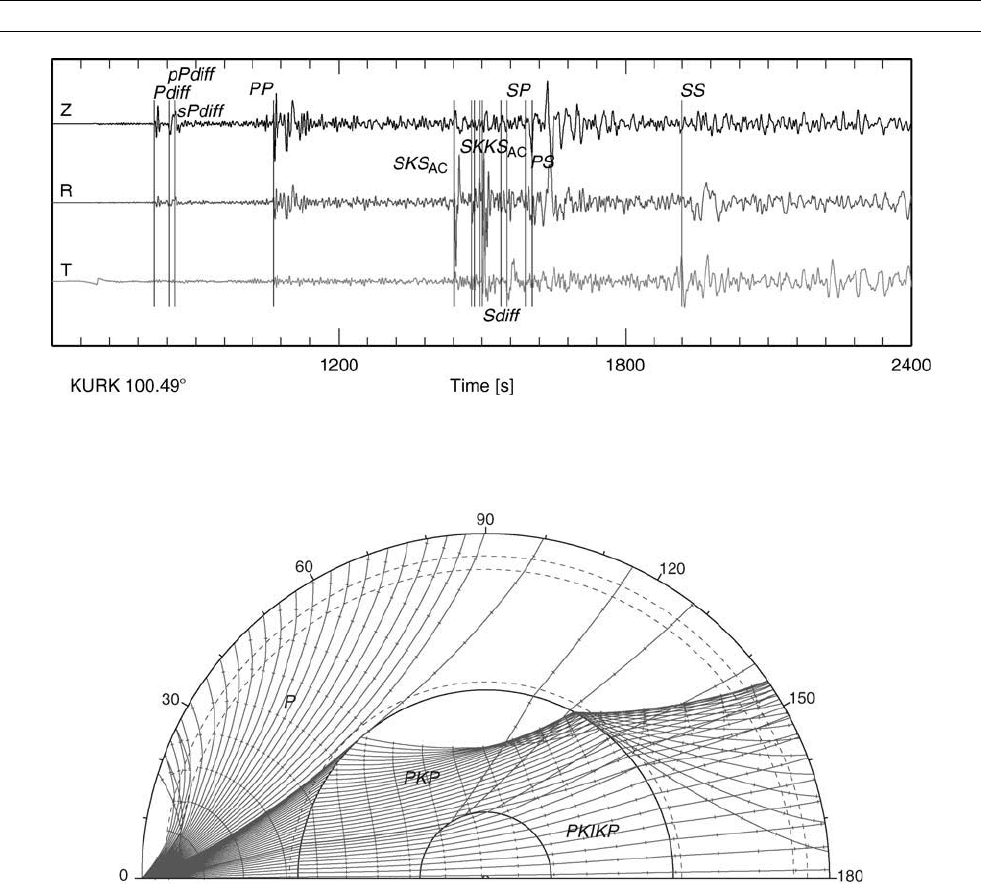
of arrivals near 145
from the source. The apparent “shadow zone”
with no P arrivals from 100
to 145
led to the discovery of the core
by Oldham at the end of the 19th century. Reflection from the bound-
ary between the inner and outer cores (PKiKP) and refraction through
outermost part of the inner core (PKIKP) produce small amplitude arri-
vals which help to fill in the gap between direct P out to 100
and the
PKP caustic. The identification of these arrivals lead to the discovery
of the inner core by Inge Lehmann. Note that the presence of the PKP
caustic means that there are no turning points for P waves in the upper
part of the core.
For S waves (Figure S20) the pattern of propagation in the mantle is
similar to that for P. However, since the P wavespeed in the outer core
is slightly higher than the S wavespeed at the base of the core, it is pos-
sible for an SKS wave to travel faster in the core and overtake the
direct S wave traveling just in the mantle. For distances beyond 82
,
the SKS phases arrives before S. Unlike the PKP waves, the SKS
family of waves (including underside reflections at the core-mantle
boundary as in SKKS ) sample the whole of the core.
The P reflections from the major internal boundaries of the Earth
can often be seen as distinct phases. In Figure S21 we show the ray
paths for PcP reflected from the core-mantle boundary and PKiKP
reflected from the inner-core boundary. The reflections can sometimes
be seen relatively close to the source but their time trajectories cut
across a number of other phases and so they can often be obscured
by other energy. The P wave refracted in the mantle and the PcP wave
reflected from the core-mantle boundary have very similar ray paths
for near grazing incidence, and so their travel time curves converge
close to 90
epicentral distance.
The strong contrast in physical properties at the core-mantle bound-
ary has the effect of inducing conversion between S and P waves.
An incident S wave at the core-mantle boundary can give rise to the
converted reflection ScP which can be quite prominent out to 60
from the source. In addition conversion on transmission into the core
generates SKP as illustrated in Figure S22.
The Earth’s surface and the underside of the core-mantle boundary
can give rise to multiply reflected phases (Figure S23) with very clear
internal caustics. The surface multiples can be tracked for P and S to
great distances and can often be recognized as distinct phases for the
third or higher multiples (PPP, SSS, etc.). The internal core reflections
also carry energy to substantial distance, and retain the chara cter of the
original wave system. Thus PKKP only has strong sensitivity to P
wave structure in the upper part of the core near the bounce point at
Figure S18 Three-component seismogram from an intermediate depth earthquake in Vanuatu recorded in Kazakhstan at approximately
100
from the source, showing a rich set of seismic phase arrivals.
Figure S19 Ray paths for major P phases. Wavefronts are indicated by ticks on the ray paths at 1 min intervals.
904 SEISMIC PHASES
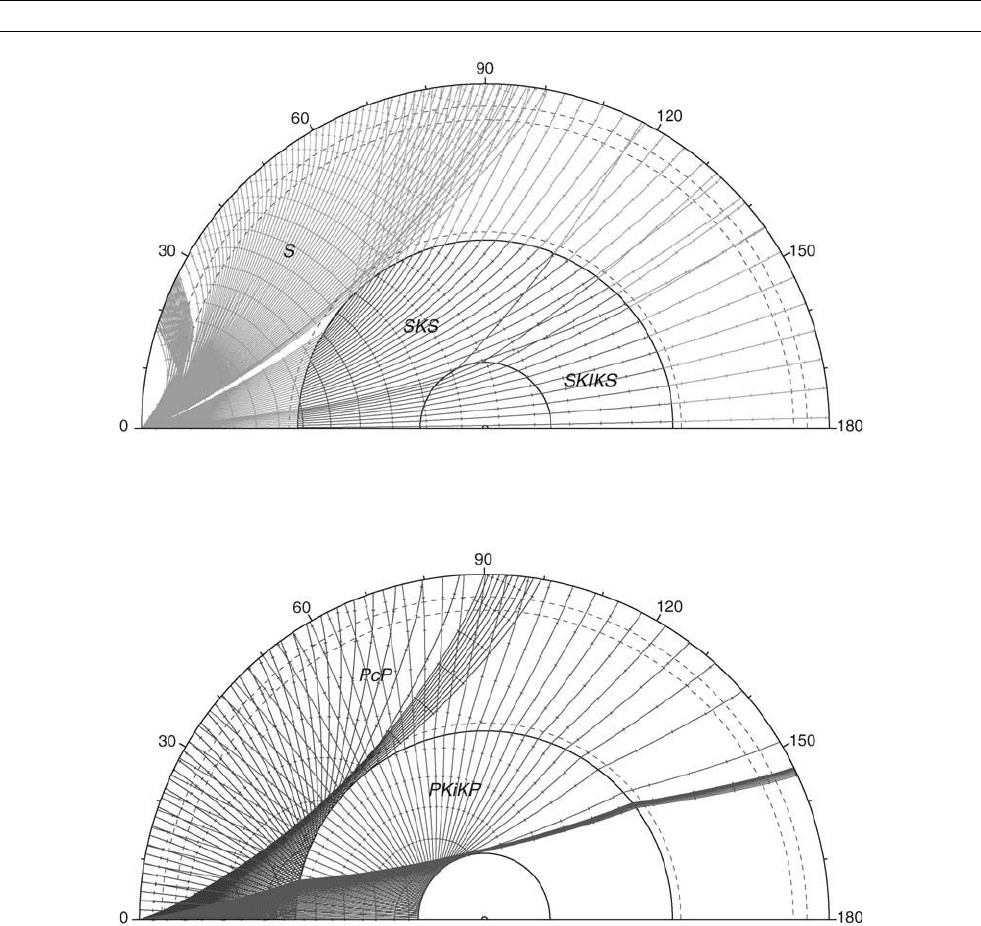
the core-mantle boundary, whereas SKKS samples the P wavespeed dis-
tribution through the whole core. The higher order multiples SKKKS,
etc. provide the closest probing of the structure in the outermost parts
of the core.
Multiply reflected waves from the core-mantle boundary are of
particular significance for horizontally polarized shear waves (SH ),
since the solid-fluid interface is close to a perfect reflector. With
efficient reflection at the Earth’s surface, a long train of multiple
ðScSÞ
H
can be established that carry with them information on the
internal structure of the Earth, in terms of the influence of internal
discontinuities.
Branches of core phases
The propagation of P waves into the Earth’s core in the PKP wave
group includes refraction back from the velocity gradients in the
outer core and reflection (PKiKP) and refraction (PKIKP) from the
inner core. The components of the wave group are also commonly
designated by a notation based on the different branches of the
travel-time curve (Figure S24).
The patterns of the travel times and the associated ray paths can be fol-
lowed in Figure S24, where the critical slowness points corresponding to
the transition between branches are clearly labeled. The details of the
positions of these critical slownesses vary slightly between different
models for the Earth’s core, but the general pattern is maintained.
The PKP
AB
branch corresponds to the waves entering the core at the
shallowest angles and PKP
BC
to waves refracted back from the lower
part of the outer core. The CD branch corresponds to wide-angle
reflection from the inner boundary (the extension of the PKiKP phase).
The PKP
DF
phases, which is equivalent to PKIKP is refracted through
the inner core. Rays penetrating into the upper part are strongly bent
and emerge near 110
at the D point, steeper entry leads to more direct
propagation through the inner core with the F point at 180
corre-
sponding to transmission without deflection.
The concentration of rays near the PKP caustic at B is reflected in
localized large amplitude arrivals for PKP near 145
. The observations
Figure S21 Ray paths for the reflected phases PcP and PKiKP.
Figure S20 Ray paths for major S phases for the AK 135 model of seismic wavespeeds.
SEISMIC PHASES 905
